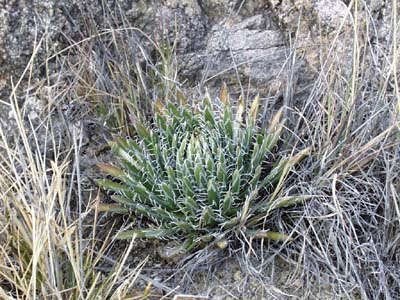Agave parviflora

Common: Santa Cruz striped agave
Family: Agavaceae
Origin: Range is from southeastern Arizona to Sonora, Mexico. Plants occur on rocky slopes in semi-desert grassland from southern Arizona to Sonora, Mexico, limited by mining and road construction, habitat degradation due to grazing, and illegal collection. Occurs at elevations from 1100 to 2400 meters.
Sun: Full sun to partial shade
Water: Infrequent water. Plants shrivel from serious drought but plump up again when watered or rained on.
Leaves are 6 to 20 cm long, 0.8 to 2 cm wide, dark green in color with white bud imprinting above and below.
Leaf margins are smooth with conspicuous white fibers. Minute teeth near the leaf base.
Flower stalk is 1 to 2.5 meters tall, slender and green to reddish in color. Flowers are cream to pale yellow, in clusters of 2 to 4, and only 14 to 27 mm long. Named for its small flowers, the smallest in the genus.
Seed capsules are 6 to20 mm long and wide, half-round and wedge-shaped. Plants offset freely, flowering between the ages of 10 to 25 years.
Agave parviflora has lost its protected status under the Endangered Species Act. It was formerly listed as Category 2, which has been eliminated.